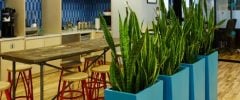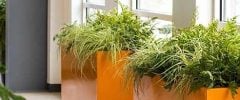7 Ways for Plantscapers & Interior Designers to Improve Their SEO Ranking

Whether you’re a plantscaper or interior designer, proper search engine optimization is essential to increase your website’s visibility and earn more business. Even if you already have an established site—or you’re building or relaunching one—without SEO, it won’t appear in search engine results pages, making it very difficult for users to locate your services. In this blog post, we will discuss strategies and best practices to optimize your website’s homepage to boost traffic, attract potential clients, and improve your search engine ranking.
SEO Terms and Definitions
Before using the strategies outlined in this post, it’s helpful to understand a few key SEO terms. These will give you a better grasp of how search engines rank websites and how you can improve your site’s visibility.
SEO: The common abbreviation for search engine optimization.
SERP: The abbreviation for search engine results page.
Search engine optimization: The practice of researching and arranging quality on-page and behind scene content and settings to improve the positioning of your website on SERPs.
Page title: The clickable headline for your website that appears on the SERP.
Title tags: The HTML elements that tell users and search engines the main topic of a particular web page.
Meta description: The snippet of text that appears under the page title in the SERP.
Internal links: The links on your website that direct to other pages on your site.
Anchor text: The clickable text used to direct visitors to other pages, both on and off your site.

Now that we’ve gone over some basic SEO terms, let’s look at several methods to better optimize your business homepage.
Strategies to Improve Your Homepage SEO
Before utilizing the tips below, first determine what keywords you want your interior design or plantscaping business page to rank for. To rank higher in search engine results pages, use keywords and phrases related to your design or indoor plant services. For example, an interior plantscaper may target the keyword “interior plant services near me.” A keyword research tool, like Google Keyword Planner, can help you find other relevant keywords. Once you’ve identified a few, incorporate them into your homepage content, which is typically the most visited page on websites.
- Include keywords in titles, subtitles, and the body of your page. This improves your chance of being found by potential customers looking for plant design or care services. The title should include local keywords and accurately reflect what users will see when clicking through to your site.
- Use the right keyword density. It’s important to use keywords throughout your content, but it’s even more important to not overuse them. Keyword stuffing doesn’t fool Google. In fact, overusing keywords will cause Google to penalize your website, lowering its rank in search results. A good rule of thumb is to use 1 to 2 keywords for every 100 words on the page.
- Write effective title tags to improve homepage SEO and encourage people to visit your plantscaping website. Include main keywords in title tags when possible, give an accurate description of the page’s content, and strive for a length of 50 to 60 characters.
- Include keywords in the meta description, as well as a brief but concise explanation of what users can expect when visiting the page. Intriguing meta descriptions will motivate users to click through to your site, increasing traffic for your design or interiorscaping services.
- Incorporate internal links to other pages on your website. This will improve your website’s SEO performance by helping search engines understand the structure of your website. In addition, users also benefit from internal links as they can provide resources and information users may look for, such as plant care advice, design ideas, or commercial plantscaping solutions.
- Choose anchor text that will help search engines understand what the page is about. Use relevant keywords as your anchor text when linking to other pages on your site.
- Insert images on your homepage to make content more appealing. Images are a great way to break up long text and keep users engaged in the information on your page. Add alt text to images using relevant keywords.
Optimize Your Website
Once your homepage is successfully optimized, follow the same SEO strategies for the remaining pages on your business website. Also, make sure your site is mobile-friendly. Google ranks websites based on their mobile-friendliness, so it’s more important than ever to have a responsive design. Better SEO performance can result in a drastic improvement in rankings, drawing in more traffic and potential interiorscaping customers.
You May Also Like
Leave a Reply
You must be logged in to post a comment.




















